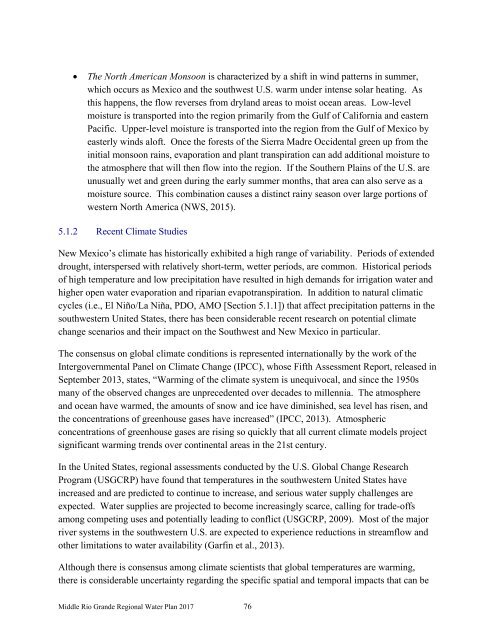Middle Rio Grande Regional Water Plan
2iUWd5b
2iUWd5b
Create successful ePaper yourself
Turn your PDF publications into a flip-book with our unique Google optimized e-Paper software.
• The North American Monsoon is characterized by a shift in wind patterns in summer,<br />
which occurs as Mexico and the southwest U.S. warm under intense solar heating. As<br />
this happens, the flow reverses from dryland areas to moist ocean areas. Low-level<br />
moisture is transported into the region primarily from the Gulf of California and eastern<br />
Pacific. Upper-level moisture is transported into the region from the Gulf of Mexico by<br />
easterly winds aloft. Once the forests of the Sierra Madre Occidental green up from the<br />
initial monsoon rains, evaporation and plant transpiration can add additional moisture to<br />
the atmosphere that will then flow into the region. If the Southern Plains of the U.S. are<br />
unusually wet and green during the early summer months, that area can also serve as a<br />
moisture source. This combination causes a distinct rainy season over large portions of<br />
western North America (NWS, 2015).<br />
5.1.2 Recent Climate Studies<br />
New Mexico’s climate has historically exhibited a high range of variability. Periods of extended<br />
drought, interspersed with relatively short-term, wetter periods, are common. Historical periods<br />
of high temperature and low precipitation have resulted in high demands for irrigation water and<br />
higher open water evaporation and riparian evapotranspiration. In addition to natural climatic<br />
cycles (i.e., El Niño/La Niña, PDO, AMO [Section 5.1.1]) that affect precipitation patterns in the<br />
southwestern United States, there has been considerable recent research on potential climate<br />
change scenarios and their impact on the Southwest and New Mexico in particular.<br />
The consensus on global climate conditions is represented internationally by the work of the<br />
Intergovernmental Panel on Climate Change (IPCC), whose Fifth Assessment Report, released in<br />
September 2013, states, “Warming of the climate system is unequivocal, and since the 1950s<br />
many of the observed changes are unprecedented over decades to millennia. The atmosphere<br />
and ocean have warmed, the amounts of snow and ice have diminished, sea level has risen, and<br />
the concentrations of greenhouse gases have increased” (IPCC, 2013). Atmospheric<br />
concentrations of greenhouse gases are rising so quickly that all current climate models project<br />
significant warming trends over continental areas in the 21st century.<br />
In the United States, regional assessments conducted by the U.S. Global Change Research<br />
Program (USGCRP) have found that temperatures in the southwestern United States have<br />
increased and are predicted to continue to increase, and serious water supply challenges are<br />
expected. <strong>Water</strong> supplies are projected to become increasingly scarce, calling for trade-offs<br />
among competing uses and potentially leading to conflict (USGCRP, 2009). Most of the major<br />
river systems in the southwestern U.S. are expected to experience reductions in streamflow and<br />
other limitations to water availability (Garfin et al., 2013).<br />
Although there is consensus among climate scientists that global temperatures are warming,<br />
there is considerable uncertainty regarding the specific spatial and temporal impacts that can be<br />
<strong>Middle</strong> <strong>Rio</strong> <strong>Grande</strong> <strong>Regional</strong> <strong>Water</strong> <strong>Plan</strong> 2017 76


